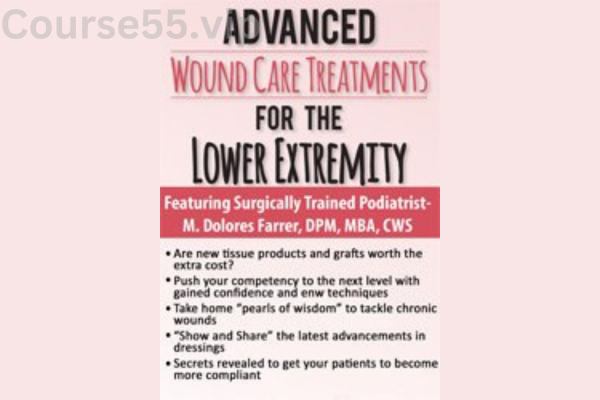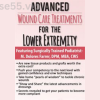Advanced Wound Care Treatments for the Lower Extremity By Dolores Farrer – PESI
$199.00 Original price was: $199.00.$23.10Current price is: $23.10.
Advanced Wound Care Treatments for the Lower Extremity: Insights by M. Dolores Farrer – Digital Download!

Advanced Wound Care Treatments for the Lower Extremity By Dolores Farrer – PESI
Overview

Advanced Wound Care Treatments for the Lower Extremity: Expert Insights from M. Dolores Farrer
In the dynamic field of wound care, M. Dolores Farrer, a distinguished expert with over 28 years of experience, focuses on addressing the complexities of chronic lower extremity ulcers. These ulcers, often resulting from diabetes, venous disease, and arterial insufficiency, pose significant challenges in treatment and recovery. In the United States alone, approximately 6 million individuals suffer from chronic wounds, a number projected to rise due to aging populations and increasing diabetes prevalence. These conditions can lead to severe complications, drastically affecting the quality of life for those affected. Through her comprehensive reviews, Farrer explores advanced wound care treatments specifically designed to manage these conditions, offering valuable insights for both healthcare professionals and patients.
Understanding Chronic Lower Extremity Ulcers
Chronic ulcers persist over time and frequently resist conventional treatment, increasing the risk of complications such as infections and amputations. Farrer categorizes these ulcers based on their underlying causes—diabetic, venous, and arterial—each requiring a unique treatment approach. Diabetic ulcers often present as deep lesions on the foot due to neuropathy and impaired circulation, while venous ulcers typically appear near the medial malleolus, characterized by shallow, irregular wounds. In contrast, arterial ulcers, caused by inadequate blood supply, form well-defined, painful lesions on pressure points, particularly the toes. Recognizing these differences is essential for developing targeted treatment strategies that optimize healing outcomes.
Types of Lower Extremity Ulcers
To effectively treat chronic lower extremity ulcers, it is crucial to distinguish between their types and characteristics. Each ulcer type requires a specific approach to treatment, as summarized below:
| Type of Ulcer | Characteristics | Typical Location | Underlying Causes |
|---|---|---|---|
| Diabetic Ulcers | Deep lesions with surrounding callus tissue | Feet | Diabetic neuropathy, reduced blood flow |
| Venous Ulcers | Shallow, irregular shape, often exudative | Medial malleolus of the leg | Venous hypertension, reflux disease |
| Arterial Ulcers | Well-defined edges, often painful | Pressure points, typically on toes | Insufficient blood flow, ischemia |
Each type of ulcer demands a specialized treatment plan. Diabetic ulcers necessitate rigorous blood sugar management alongside local wound care, while venous ulcers benefit from compression therapy to improve circulation. Arterial ulcers require urgent intervention to restore blood flow and prevent further tissue damage. Recognizing these distinctions helps healthcare providers deliver personalized treatment while reinforcing the importance of a multidisciplinary approach.
Innovative Therapies in Advanced Wound Care
Standard wound care treatments often fail to achieve full healing in chronic cases, making advanced therapies essential for effective management. Farrer highlights several cutting-edge treatment methods designed to enhance the healing process by addressing the specific challenges of different ulcer types.
- Collagen Products – These treatments provide structural support for cell growth, attracting essential healing cells to the wound site and facilitating tissue regeneration.
- Biological Dressings – Composed of extracellular matrix components, these dressings replicate the natural wound environment, promoting granulation tissue formation and faster healing.
- Platelet-Derived Growth Factors and Platelet-Rich Plasma – These regenerative therapies utilize the body’s natural healing factors to accelerate tissue repair and improve wound closure rates.
- Negative Pressure Wound Therapy (NPWT) – By applying controlled suction to the wound, NPWT enhances blood flow, reduces excess fluid, and stimulates new tissue growth, making it particularly effective for deep, complex wounds.
- Hyperbaric Oxygen Therapy (HBOT) – This method increases oxygen delivery to damaged tissues in a high-pressure environment, significantly enhancing cell metabolism and accelerating the healing process.
Each of these therapies complements traditional wound care methods such as debridement, infection management, and compression therapy for venous ulcers. In her research and training programs, Farrer emphasizes the importance of integrating these advanced therapies into comprehensive treatment plans tailored to each patient’s needs.
Comprehensive Approaches to Wound Care
Farrer’s extensive experience underscores the necessity of a holistic approach to wound care, one that extends beyond treating the ulcer itself. Effective wound management must account for the patient’s overall health and underlying conditions, ensuring that interventions not only address the wound but also mitigate complications such as infections and high amputation risks, particularly for diabetic patients.
As the field of wound care continues to evolve, staying informed about the latest advancements in treatment is essential for healthcare providers. Farrer’s work contributes to an ongoing dialogue within the medical community, helping practitioners refine their treatment strategies and improve patient outcomes. By integrating cutting-edge therapies with traditional approaches, healthcare professionals can enhance healing rates, reduce complications, and ultimately improve the quality of life for patients suffering from chronic wounds.
Conclusion
M. Dolores Farrer’s in-depth reviews of advanced wound care treatments provide invaluable insights into managing one of healthcare’s most persistent challenges—chronic lower extremity ulcers. With the rising incidence of diabetes and venous diseases, her emphasis on specialized, evidence-based treatment strategies reflects a deep understanding of the complexities of wound healing. As medical advancements continue, incorporating innovative wound care methods into standard treatment protocols can lead to better recovery outcomes, fewer complications, and improved patient well-being. Farrer’s work highlights the critical role of interdisciplinary collaboration and ongoing research in effectively addressing these challenging conditions.
Frequently Asked Questions:
Business Model Innovation: We operate a group buying strategy, allowing participants to share costs and access popular courses at reduced prices. This model benefits individuals with limited financial resources, despite concerns from content creators about distribution methods.
Legal Considerations: The legality of our operations involves complex issues. Although we don’t have explicit permission from course creators to resell their content, there are no specific resale restrictions stated at the time of purchase. This ambiguity creates an opportunity for us to provide affordable educational resources.
Quality Control: We ensure that all course materials purchased are identical to those offered directly by the creators. However, it’s important to understand that we are not official providers. As such, our offerings do not include:
– Live coaching calls or sessions with the course author.
– Access to exclusive author-controlled groups or portals.
– Membership in private forums.
– Direct email support from the author or their team.
We aim to reduce the cost barrier in education by offering these courses independently, without the premium services available through official channels. We appreciate your understanding of our unique approach.
Be the first to review “Advanced Wound Care Treatments for the Lower Extremity By Dolores Farrer – PESI” Cancel reply
You must be logged in to post a review.

 Acceptance and Commitment Therapy (ACT) Made Easy: Innovative Techniques for Depression, Anxiety, Trauma & Personality Disorders By Douglas Fogel - PESI
Acceptance and Commitment Therapy (ACT) Made Easy: Innovative Techniques for Depression, Anxiety, Trauma & Personality Disorders By Douglas Fogel - PESI 














Reviews
There are no reviews yet.